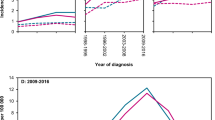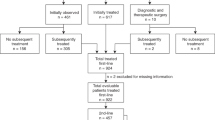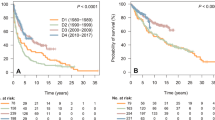Abstract
Treatment for follicular lymphoma (FL) improved with rituximab. In Sweden, first-line rituximab was gradually introduced between 2003 and 2007, with regional differences. The first national guidelines for FL were published in November 2007, recommending rituximab in first-line therapy. Using the population-based Swedish Lymphoma Registry, 2641 patients diagnosed with FL from 2000 to 2010 were identified and characterized by year and region of diagnosis, age (median, 65 years), gender (50% men), first-line therapy and clinical risk factors. Overall and relative survivals were estimated by calendar periods (2000–2002, 2003–2007 and 2008–2010) and region of diagnosis. With each period, first-line rituximab use and survival increased. Survival was superior in regions where rituximab was quickly adopted and inferior where slowly adopted. These differences were independent in multivariable analyses. Ten-year relative survival for patients diagnosed 2003–2010 was 92%, 83%, 78% and 64% in the age groups 18–49, 50–59, 60–69 and ⩾70, respectively. With increasing rituximab use, male sex emerged as an adverse factor. Survival improved in all patient categories, particularly in elderly women. The introduction and the establishment of rituximab have led to a nationwide improvement in FL survival. However, rituximab might be inadequately dosed in younger women and men of all ages.
This is a preview of subscription content, access via your institution
Access options
Subscribe to this journal
Receive 12 print issues and online access
$259.00 per year
only $21.58 per issue
Buy this article
- Purchase on Springer Link
- Instant access to full article PDF
Prices may be subject to local taxes which are calculated during checkout




Similar content being viewed by others
References
Harris NL, Swerdlow SH, Jaffe ES, Ott G, Nathwani D . Follicular lymphoma. In: Swerdlow SH, Campo E, Harris NL, Jaffe ES, Pileri SA, Stein H (eds). WHO Classification of Tumours of Haematopoietic and Lymphoid Tissues. IARC: Lyon, France, 2008, pp 220–226.
Hiddemann W, Cheson BD . How we manage follicular lymphoma. Leukemia 2014; 28: 1388–1395.
Bezombes C, Fournie JJ, Laurent G . Direct effect of rituximab in B-cell-derived lymphoid neoplasias: mechanism, regulation, and perspectives. Mol Cancer Res 2011; 9: 1435–1442.
McLaughlin P, Grillo-Lopez AJ, Link BK, Levy R, Czuczman MS, Williams ME et al. Rituximab chimeric anti-CD20 monoclonal antibody therapy for relapsed indolent lymphoma: half of patients respond to a four-dose treatment program. J Clin Oncol 1998; 16: 2825–2833.
Marcus R, Imrie K, Belch A, Cunningham D, Flores E, Catalano J et al. CVP chemotherapy plus rituximab compared with CVP as first-line treatment for advanced follicular lymphoma. Blood 2005; 105: 1417–1423.
Hiddemann W, Kneba M, Dreyling M, Schmitz N, Lengfelder E, Schmits R et al. Frontline therapy with rituximab added to the combination of cyclophosphamide, doxorubicin, vincristine, and prednisone (CHOP) significantly improves the outcome for patients with advanced-stage follicular lymphoma compared with therapy with CHOP alone: results of a prospective randomized study of the German Low-Grade Lymphoma Study Group. Blood 2005; 106: 3725–3732.
Herold M, Haas A, Srock S, Neser S, Al-Ali KH, Neubauer A et al. Rituximab added to first-line mitoxantrone, chlorambucil, and prednisolone chemotherapy followed by interferon maintenance prolongs survival in patients with advanced follicular lymphoma: an East German Study Group Hematology and Oncology Study. J Clin Oncol 2007; 25: 1986–1992.
Salles G, Mounier N, de Guibert S, Morschhauser F, Doyen C, Rossi JF et al. Rituximab combined with chemotherapy and interferon in follicular lymphoma patients: results of the GELA-GOELAMS FL2000 study. Blood 2008; 112: 4824–4831.
Hainsworth JD, Burris HA III, Morrissey LH, Litchy S, Scullin DC Jr Bearden JD III et al Rituximab monoclonal antibody as initial systemic therapy for patients with low-grade non-Hodgkin lymphoma. Blood 2000; 95: 3052–3056.
Colombat P, Salles G, Brousse N, Eftekhari P, Soubeyran P, Delwail V et al. Rituximab (anti-CD20 monoclonal antibody) as single first-line therapy for patients with follicular lymphoma with a low tumor burden: clinical and molecular evaluation. Blood 2001; 97: 101–106.
Ghielmini M, Schmitz SF, Cogliatti SB, Pichert G, Hummerjohann J, Waltzer U et al. Prolonged treatment with rituximab in patients with follicular lymphoma significantly increases event-free survival and response duration compared with the standard weekly x4 schedule. Blood 2004; 103: 4416–4423.
Kimby E, Jurlander J, Geisler C, Hagberg H, Holte H, Lehtinen T et al. Long-term molecular remissions in patients with indolent lymphoma treated with rituximab as a single agent or in combination with interferon alpha-2a: a randomized phase II study from the Nordic Lymphoma Group. Leuk Lymphoma 2008; 49: 102–112.
Johnson PW, Rohatiner AZ, Whelan JS, Price CG, Love S, Lim J et al. Patterns of survival in patients with recurrent follicular lymphoma: a 20-year study from a single center. J Clin Oncol 1995; 13: 140–147.
Fisher RI, LeBlanc M, Press OW, Maloney DG, Unger JM, Miller TP . New treatment options have changed the survival of patients with follicular lymphoma. J Clin Oncol 2005; 23: 8447–8452.
Liu Q, Fayad L, Cabanillas F, Hagemeister FB, Ayers GD, Hess M et al. Improvement of overall and failure-free survival in stage IV follicular lymphoma: 25 years of treatment experience at The University of Texas MD Anderson Cancer Center. J Clin Oncol 2006; 24: 1582–1589.
Tan D, Horning SJ, Hoppe RT, Levy R, Rosenberg SA, Sigal BM et al. Improvements in observed and relative survival in follicular grade 1-2 lymphoma during 4 decades: the Stanford University experience. Blood 2013; 122: 981–987.
Nationellt kvalitetsregister för lymfom. Available at: http://www.cancercentrum.se/sv/INCA/kvalitetsregister/Blodcancer/lymfom (last accessed 30 December 2013).
Svenska lymfomgruppen. Available at: http://www.swedishlymphoma.se (last accessed 30 December 2013).
Solal-Celigny P, Roy P, Colombat P, White J, Armitage JO, Arranz-Saez R et al. Follicular lymphoma international prognostic index. Blood 2004; 104: 1258–1265.
Vijungco J, Phillips R, Hendrickson FR, Millburn LF . Stage I and II non-Hodgkin's lymphoma. Results of regional radiation therapy. Am J Roentgenol Radium Ther Nucl Med 1973; 117: 45–49.
Ardeshna KM, Smith P, Norton A, Hancock BW, Hoskin PJ, MacLennan KA et al. Long-term effect of a watch and wait policy versus immediate systemic treatment for asymptomatic advanced-stage non-Hodgkin lymphoma: a randomised controlled trial. Lancet 2003; 362: 516–522.
Brandt L, Kimby E, Nygren P, Glimelius B . A systematic overview of chemotherapy effects in indolent non-Hodgkin's lymphoma. Acta Oncol 2001; 40: 213–223.
Schouten HC, Qian W, Kvaloy S, Porcellini A, Hagberg H, Johnson HE et al. High-dose therapy improves progression-free survival and survival in relapsed follicular non-Hodgkin's lymphoma: results from the randomized European CUP trial. J Clin Oncol 2003; 21: 3918–3927.
Williams CD, Harrison CN, Lister TA, Norton AJ, Blystad AK, Coiffier B et al. High-dose therapy and autologous stem-cell support for chemosensitive transformed low-grade follicular non-Hodgkin's lymphoma: a case-matched study from the European Bone Marrow Transplant Registry. J Clin Oncol 2001; 19: 727–735.
Wahlin BE, Sundstrom C, Sander B, Christensson B, Jeppsson-Ahlberg A, Hjalmarsson E et al. Higher World Health Organization grades of follicular lymphoma correlate with better outcome in two Nordic Lymphoma Group trials of rituximab without chemotherapy. Leuk Lymphoma 2014; 55: 288–295.
van Oers MH, Klasa R, Marcus RE, Wolf M, Kimby E, Gascoyne RD et al. Rituximab maintenance improves clinical outcome of relapsed/resistant follicular non-Hodgkin lymphoma in patients both with and without rituximab during induction: results of a prospective randomized phase 3 intergroup trial. Blood 2006; 108: 3295–3301.
Salles G, Seymour JF, Offner F, Lopez-Guillermo A, Belada D, Xerri L et al. Rituximab maintenance for 2 years in patients with high tumour burden follicular lymphoma responding to rituximab plus chemotherapy (PRIMA): a phase 3, randomised controlled trial. Lancet 2011; 377: 42–51.
Rummel MJ, Niederle N, Maschmeyer G, Banat GA, von Grunhagen U, Losem C et al. Bendamustine plus rituximab versus CHOP plus rituximab as first-line treatment for patients with indolent and mantle-cell lymphomas: an open-label, multicentre, randomised, phase 3 non-inferiority trial. Lancet 2013; 381: 1203–1210.
Cox DR . Regression models and life-tables. J R Stat Soc 1972; 34: 187–220.
Henson DE, Ries LA . The relative survival rate. Cancer 1995; 76: 1687–1688.
Dickman PW, Adami HO . Interpreting trends in cancer patient survival. J Intern Med 2006; 260: 103–117.
Ederer F, Heise H . Instructions to IBM 650 Programmers in Processing Survival Computations. Methodological Note No. 10, End Results Evaluation Section. National Cancer Institute: Bethesda, MD, USA, 1959.
Perme MP, Henderson R, Stare J . An approach to estimation in relative survival regression. Biostatistics 2009; 10: 136–146.
Conconi A, Motta M, Bertoni F, Piona C, Stathis A, Wannesson L et al. Patterns of survival of follicular lymphomas at a single institution through three decades. Leuk Lymphoma 2010; 51: 1028–1034.
Schulz H, Bohlius JF, Trelle S, Skoetz N, Reiser M, Kober T et al. Immunochemotherapy with rituximab and overall survival in patients with indolent or mantle cell lymphoma: a systematic review and meta-analysis. J Natl Cancer Inst 2007; 99: 706–714.
Tomita N, Kodama F, Motomura S, Koharazawa H, Fujita H, Harano H et al. Prognostic factors in diffuse large B-cell lymphoma treated by risk-adopted therapy. Intern Med 2006; 45: 247–252.
Ngo L, Hee SW, Lim LC, Tao M, Quek R, Yap SP et al. Prognostic factors in patients with diffuse large B cell lymphoma: before and after the introduction of rituximab. Leuk Lymphoma 2008; 49: 462–469.
Riihijarvi S, Taskinen M, Jerkeman M, Leppa S . Male gender is an adverse prognostic factor in B-cell lymphoma patients treated with immunochemotherapy. Eur J Haematol 2011; 86: 124–128.
Abrahamsson A, Albertsson-Lindblad A, Brown PN, Baumgartner-Wennerholm S, Pedersen LM, D'Amore F et al. Real world data on primary treatment for mantle cell lymphoma: a Nordic Lymphoma Group observational study. Blood 2014; 124: 1288–1295.
Carella AM, de Souza CA, Luminari S, Marcheselli L, Chiappella A, di Rocco A et al. Prognostic role of gender in diffuse large B-cell lymphoma treated with rituximab containing regimens: a Fondazione Italiana Linfomi/Grupo de Estudos em Molestias Onco-Hematologicas retrospective study. Leuk Lymphoma 2013; 54: 53–57.
Muller C, Murawski N, Wiesen MH, Held G, Poeschel V, Zeynalova S et al. The role of sex and weight on rituximab clearance and serum elimination half-life in elderly patients with DLBCL. Blood 2012; 119: 3276–3284.
Pfreundschuh M, Muller C, Zeynalova S, Kuhnt E, Wiesen MH, Held G et al. Suboptimal dosing of rituximab in male and female patients with DLBCL. Blood 2014; 123: 640–646.
O'Brien SM, Kantarjian H, Thomas DA, Giles FJ, Freireich EJ, Cortes J et al. Rituximab dose-escalation trial in chronic lymphocytic leukemia. J Clin Oncol 2001; 19: 2165–2170.
Statistiska centra lbyrån. Available at: http://www.scb.se (last accessed 1 August 2012).
Wahlin BE, Yri OE, Kimby E, Holte H, Delabie J, Smeland EB et al. Clinical significance of the WHO grades of follicular lymphoma in a population-based cohort of 505 patients with long follow-up times. Br J Haematol 2012; 156: 225–233.
Acknowledgements
We thank the Swedish Lymphoma Registry and the Swedish Lymphoma Group for providing data for this study. This work was funded by grants from Cancerfonden, Svenska Sällskapet för Medicinsk Forskning (SSMF) and KI/SLL (a joint grant from Karolinska Institutet and Stockholm County Council).
Author information
Authors and Affiliations
Corresponding author
Ethics declarations
Competing interests
The authors declare no conflict of interest.
Additional information
Supplementary Information accompanies this paper on the Leukemia website
Supplementary information
41375_2015_BFleu2014251_MOESM132_ESM.doc
Overall and relative survival in Sweden at 5 and 10 years, in women and men in different age groups, stratified by era (DOC 104 kb)
Rights and permissions
About this article
Cite this article
Junlén, H., Peterson, S., Kimby, E. et al. Follicular lymphoma in Sweden: nationwide improved survival in the rituximab era, particularly in elderly women: a Swedish Lymphoma Registry Study. Leukemia 29, 668–676 (2015). https://doi.org/10.1038/leu.2014.251
Received:
Revised:
Accepted:
Published:
Issue Date:
DOI: https://doi.org/10.1038/leu.2014.251
This article is cited by
-
Comparative analysis of rituximab or obinutuzumab combined with CHOP in first-line treatment of follicular lymphoma
Journal of Cancer Research and Clinical Oncology (2023)
-
Clinical characteristics and prognosis of patients with co-existing follicular lymphoma and diffuse large B-cell lymphoma components in rituximab era
Journal of Cancer Research and Clinical Oncology (2023)
-
Causes of death of patients with follicular lymphoma in the Netherlands by stage and age groups: a population-based study in the pre- and post-rituximab era
Leukemia (2022)
-
Risk and prognosis of secondary breast cancer after radiation therapy for non-Hodgkin lymphoma: a massive population-based analysis
Clinical and Translational Oncology (2022)
-
Stage-specific trends in primary therapy and survival in follicular lymphoma: a nationwide population-based analysis in the Netherlands, 1989–2016
Leukemia (2021)



